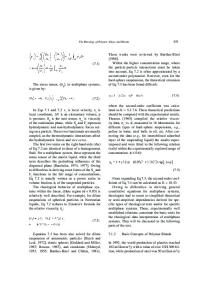Morphology of Polymer Blends
In the first part of the chapter several methods used to observe morphology of polymer blends are presented. Various optical microscopic methods are reviewed, including such modern techniques as photon tunneling microscopy (PTM), scanning near-field optic
- PDF / 1,906,050 Bytes
- 30 Pages / 595 x 842 pts (A4) Page_size
- 0 Downloads / 365 Views
MORPHOLOGY OF POLYMER BLENDS
T. Inoue
Yamagata University, Yonezawa, Japan
8.1
Abstract
In the first part of the chapter several methods used to observe morphology of polymer blends are presented. Various optical microscopic methods are reviewed, including such modern techniques as photon tunneling microscopy (PTM), scanning near-field optical microscopy (SNOM), phase measurement interference microscopy (PMIM), surface plasmon microscopy (SPM) and optical waveguide microscopy (OWM). Many of these methods have been developed to study surfaces and thin films. However, they can also be applied to polymer blend morphology. For transmission electron microscopy (TEM), many staining techniques are described. The double staining method, e.g., using OsO4 and RuO4, was shown to be a powerful tool for enhancing contrast in three and four component systems showing complex morphology. Importance of the etching procedures for scanning electron microscopy (SEM) has been demonstrated to reveal real morphology. A SEM observation by back-scattered electrons from the microtomed and stained specimen was introduced as a novel method for obtaining high quality images. There are serious problems with the digital image analysis (DIA) of micrographs, using commercially available DIA systems. Recently developed, sophisticated DIA methods are introduced in the chapter. The methods provide means for quantification of the polymer blends morphology, and correlation of the extracted parameters with measured properties. In addition to DIA, a light scattering method has been also used for the quantification of morphology. For the better understanding of blend morphologies, the fundamental mechanisms of morphology development are discussed, viz. the liquid-solid phase transition (crystallization), the liquid-liquid phase separation (e.g., spinodal decomposition under non-isoquench depth), as well as the complex mechanism of the morphology generation that results from the competition between these two transitions. The effects of chemical reactions and flow fields on morphology development have also been discussed. Finally, several evidences of a local “structure” in single-phase polymer-polymer mixtures are presented.
L.A. Utracki (Ed.), Polymer Blends Handbook, 547-576. © 2003 Kluwer Academic Publishers. Printed in the Netherlands.
548
8.2
T. Inoue
Introduction
By blending dissimilar polymers one can design a variety of morphologies. Morphology control is of prime importance for polymer blends. In the first part of this chapter, a review is given on the microscopic methods to observe polymer blend morphology. This will provide a guide for selection of the most suitable methods of morphology observation. The advantages as well as the limitations of microscopic methods are discussed. In the second part, digital image processing and light scattering methods are presented for morphology quantification. The quantification of morphology is required to discuss the morphologyproperties relationships. In the following part of this chapter, a num
Data Loading...











